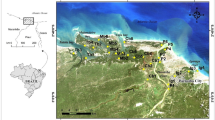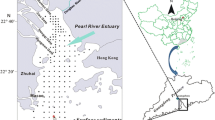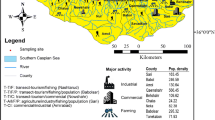Abstract
The geochemistry, mineralogy, and grain size distribution of several estuarine cohesive sediment samples from potentially human-influenced areas without such an influence were analyzed to determine the natural heavy metal content and evaluate its impact on the Bahía Blanca estuarine environment. The data were compared with different ranges of concentrations for heavy metals in marine sediments established by the NOAA Screening Quick Reference Tables in which values range from background levels to those considered toxic to the marine environment. Our total heavy metal contents were below the established hazardous levels in all the analyzed samples, even though the potentially human-influenced areas (harbors, industry, urban spread) showed the highest total concentration values as well as greater percentages of bioavailable compounds. This would imply a low and not extensive anthropogenic input into the environment. The relatively high proportions in which Cd, Pb, and Cr appear as bioavailable compounds at some sites not influenced by human activity suggest the presence of a natural source for these elements. This could be attributed to the weathering of naturally occurring volcanic minerals, indicating that special care must be taken when monitoring of sediment for anthropogenic activity is carried out within this environment. According to the results obtained, and in order to minimize the environmental impact caused by periodic water injection dredging, relocation of sewage outfalls from vessel mooring areas into open waters is strongly recommended.






Similar content being viewed by others

References
Borel CM, Gómez EA (2006) Palinología del Holoceno del Canal del Medio, estuario de Bahía Blanca (Buenos Aires, Argentina). Ameghiniana 43(2):399–412
Buchman MF (2008) NOAA Screening Quick Reference Tables, NOAA OR&R Report 08-1. Office of Response and Restoration Division, National Oceanic and Atmospheric Administration, Seattle, 34 pp
Butman B, Bothner MH (1998) Predicting the long-term fate of sediments and contaminants in Massachusetts Bay. U.S. Geological Survey Sheet FS, pp 172–97
Gómez EA, Borel CM, Aguirre ML, Martínez DE (2008) Radiocarbon reservoir ages and hard-water effect for the northeastern coastal waters of Argentina. Radiocarbon 50(1):119–129
Grecco LE, Marcos AO, Gomez EA, Botté S, Marcovecchio JE (2006) Natural content and anthropogenic input of heavy metals in sediments from Bahia Blanca estuary (Argentina). J Coast Res S39:1021–1025
Krumbein W, Pettijohn F (1956) Manual of sedimentary petrography. Appleton-Century-Crofts, New York, p 549
Lacerda LD, Souza CM, Pestana MHD (1988) Geochemical distribution of Cd, Cu, Cr, and Pb in sediments of estuarine areas along the Southeastern Brazilian coast. In: Seelinger U, de Lacerda LD, Patchineelam SR (eds) Metals in coastal environments of Latin America. Springer, Heidelberg, pp 86–99
Maddock JEL, Lopes CEA (1988) Behaviour of pollutant metals in Aquatic sediments. In: Seeliger U, Lacerda LD, Patchineelam SR (eds) Metals in coastal environments of Latin America. Springer, Heindelberg, pp 100–105
Marcovecchio JE, Ferrer LD (2005) Distribution and geochemical partitioning of heavy metals in sediments of the Bahía Blanca estuary, Argentina. J Coast Res 21(4):826–834
Marcovecchio JE, L Ferrer, A Barral, M Scagliola, A Pucci, 1998. A model for geochemical partitioning of heavy metals in the Mar del Plata coastal ecosystem, Argentina. In: Environmental Geochemistry in the Tropics, JC Wasserman, E Vieira da Silva-Filho, R Villas-Boas (eds), Springer-Verlag , Heidelberg, Ch. X: 131-141.
Megalatti N, Robbe O, Marchandise P, Astruk M (1983) A new chemical extraction procedure in the fractionation of heavy metals in sediments. In: Förstner U (ed) Heavy metals in the environment, vol 4. CEP Consult Ltd., Edinburgh, pp 1090–1093
Signell R (1997) Predicting the impact of relocation Boston’s sewage outfall. Effluent dilution simulation in Massachusetts Bay. U.S. Geological Survey Sheet, Fact Sheet FS 185-97, p 2
Teruggi ME (1957) The nature and origin of Argentine loess. J Sed Petrol 27(3):322–332
Author information
Authors and Affiliations
Corresponding author
Additional information
Responsible Editor: Ashish Mehta
Rights and permissions
About this article
Cite this article
Grecco, L.E., Gómez, E.A., Botté, S.E. et al. Natural and anthropogenic heavy metals in estuarine cohesive sediments: geochemistry and bioavailability. Ocean Dynamics 61, 285–293 (2011). https://doi.org/10.1007/s10236-010-0354-7
Received:
Accepted:
Published:
Issue Date:
DOI: https://doi.org/10.1007/s10236-010-0354-7



